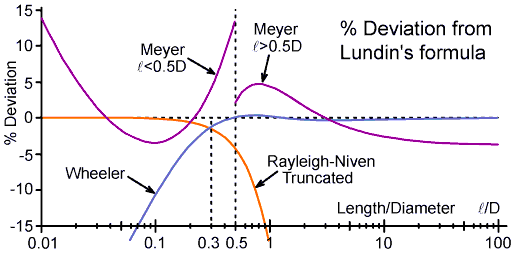|
|
|
|
|
|
A note from 2007 on an incorrect inductance formula
|
Wheeler's long-coil formula is adequate for many engineering
calculations when |
|
D ≥ 2 |
kL = 0.9694(D/ |
|
|
2 |
kL = 0.9617exp{-0.2913(D/ |
|
|
where exp{x}=ex Using Lundin's handbook formula as datum, a comparison between this formula and Wheeler's long-coil formula is shown in the graph below: |

|
Meyer's long-coil formula (for kL = (2/π)( and so he should have been aware of it. If this formula is used for What is particularly problematic about Meyer's approximation is that it has been used in at least one computer program distributed to Radio Amateurs. Its accuracy in the most important region from |
|
Reference: "Accurate Single-Layer-Solenoid Inductance Calculations", Hank Meyer W6GGV, QST Technical Correspondence, April 1992, p76-77. "Corrections to Accurate Single-Layer Solenoid Inductance Calculations", Hank Meyer. QST July 1992, p73. Complains of inaccuracy of Wheeler's formula, but fails to appreciate that Wheeler's formula is a current-sheet approximation. Confuses coil-former diameter with coil diameter. Fits Nagaoka's coefficient (taken from Langford-Smith's graph) to simple functions, but these functions are seriously inaccurate in the region of interest. The long-coil formula is far less accurate than Wheeler's formula, and the short-coil formula is less accurate than truncating the Rayleigh-Niven formula to a single term. Equation 4, for Rosa's mutual inductance correction is only accurate to 20.6% and does not return 0 when N=1. Computer programs developed from this article should be avoided. Meyer adds his own transcription error also: the last term of Eq. 5 should be (5B6/1024){...}. Eq. 6 is not Nagaoka's coefficient, it is the Webster-Havelock formula [Grover 1946] p 121). The accuracy of Eq. 5 without corrections is 0.66% and Eq.6 is 0.06%, not one part in 105 as stated. April: Ref 3 should read pp1-33. July p73: The statement that inductance is independent of frequency is incorrect. |
© D W Knight 2007, 2010, 2016.
|
|
|
|
|
|